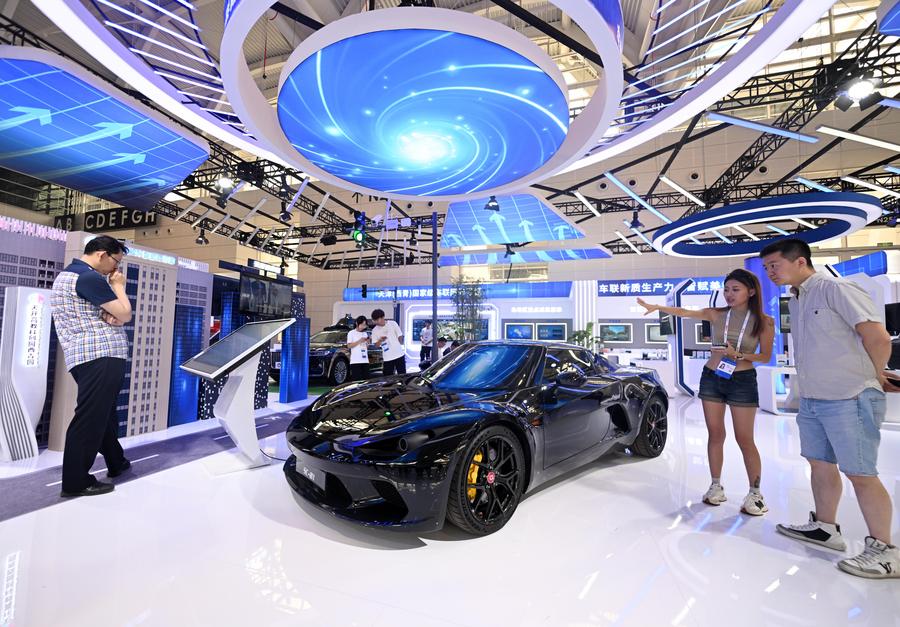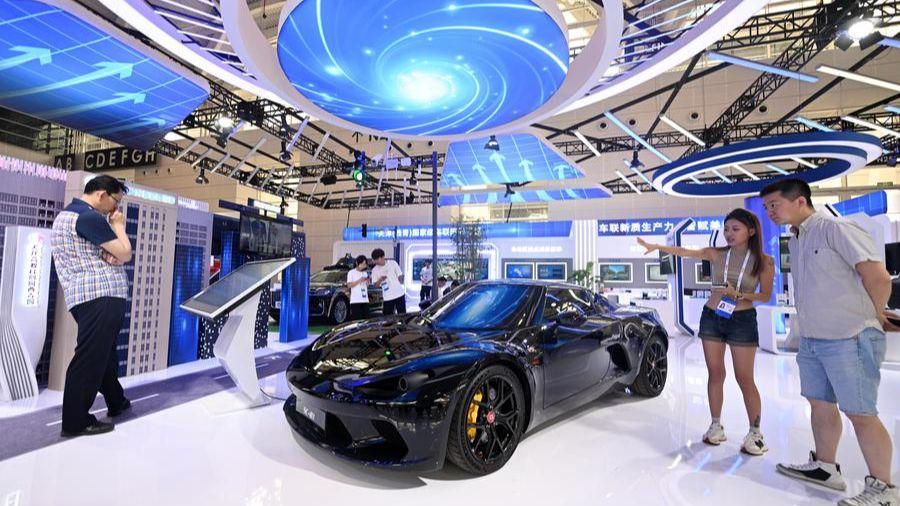
Visitors look at a new-energy sports car displayed at the World Intelligence Expo 2024 in north China's Tianjin, June 22, 2024. (Xinhua/Zhao Zishuo)
BEIJING, July 17 (Xinhua) -- Recently, a foreign vlogger's astonishment at the prevalence of electric vehicles (EVs) on China's streets has gone viral on social media.
"Upon arriving in China, I noticed that most of the cars and buses on the streets are powered by electricity. There is no sound of engines, and even in the bustling downtown areas, it is very quiet," the vlogger remarked.
Ten years ago, new energy vehicle (NEV) was still a novelty while currently, China has more than 20 million NEVs on the road.
-- Garnering market share with quality products
China's production and sales of NEVs continued to maintain rapid growth in the first six months of this year, with the NEV market share steadily increasing in the domestic market, industry data showed.
During the period, the production of NEVs reached about 4.93 million units, rising 30.1 percent year on year, according to data from the China Association of Automobile Manufacturers (CAAM).
The sales of NEVs stood at 4.94 million units, growing by 32 percent from a year earlier. The market share of NEVs in China reached 35.2 percent by the end of June.
In June alone, the production and sales of NEVs hit 1 million units and 1.05 million units, respectively, up 28.1 percent and 30.1 percent year on year.
The rapid growth of production and sales of NEVs indicates the better quality of products and positive recognition from car owners, said Wu Songquan, a senior expert at the China Automotive Technology and Research Center Co , Ltd., adding that the continuous increase in sales of NEVs not only drives the development of the automobile industrial and supply chains, but also has a significant role in promoting economic growth.
In the second half of this year, the launch of more car models and the implementation of trade-in policy will be conducive to the further growth in the NEV market. Overall, this year's production and sales scale of NEVs is expected to reach 11.5 million units, Wu noted.
-- Chinese NEV brands achieving breakthroughs
Chinese-made NEVs registered fast growth in both production and sales during the first half of this year. By the end of June this year, the production and sales of NEVs made in China exceeded 30 million units, according to the CAAM.
Many Chinese self-developed NEV enterprises have striven for market share during the same period and achieved remarkable breakthroughs.
On July 4, China's carmaker BYD opened its Thailand plant, as its 8 millionth NEV rolled off the assembly line in the factory, marking a milestone in the company's overseas expansion.
Data showed that BYD sold 341,700 NEVs in June, with a cumulative sales volume of 1.61 million units in the first half of the year, representing a year-on-year increase of 28.46 percent.
In the first half of the year, Seres' cumulative car sales volume reached 200,900 units, up 348.55 percent year on year. Among them, Seres sold 182,600 NEVs, marking a year-on-year increase of 608.83 percent.
In June alone, NIO delivered a total of 21,200 new cars, up 98 percent year on year. In the second quarter, NIO delivered 57,400 new cars, up 143.9 percent year on year and in the first half of the year, NIO delivered a total of 87,400 new cars, increasing by 60.2 percent year on year.
In June, the delivery volume of Xiaomi SU7 exceeded 10,000 units while in July, it is expected to continue to exceed 10,000 units.
Chen Shihua, deputy secretary-general of the CAAM, pointed out two reasons for the continuous improvement of the market share of Chinese self-developed brand passenger cars, namely the rapid growth of NEV sales and the expansion of automobile exports, with the export market basically dominated by self-developed brands.
-- Improvement in NEV charging facilities
Charging issues are considered as the "last mile" in the promotion of EVs.
As of the end of June, China had erected 10.24 million units of charging infrastructure throughout the country, marking a significant 54 percent year-on-year expansion, said Tong Zongqi, deputy secretary-general of the China Electric Vehicle Charging Infrastructure Promotion Alliance (EVCIPA).
In the first half of this year, the increase in charging infrastructure reached 1.65 million units, which can basically meet the needs of the surging sales of NEVs, statistics from EVCIPA showed.
"Of course, there are still issues of unbalanced development and unreasonable layout in the construction of charging piles," Tong said.
In the southern region and the eastern coastal areas of China, charging facilities have gone through the stage of optimization and improvement due to the prevalence of NEVs while in northeast and northwest China, charging infrastructure need to be established from scratch as gasoline cars are still common means of transportation.
Xiaoju Charging, a digital and intelligent charging infrastructure operator under DiDi Global Inc., has recently launched the accelerated charging function, aiming to provide NEV car owners with the fast charging service experience.
Wang Kun, the product manager of Xiaoju Charging, introduced that charging speed has become the most concerned factor for car owners.
Based on real-time intelligent scheduling of charging power by algorithm, Xiaoju Charging's accelerated charging function improves the power output efficiency and saves charging time.
(Edited by Tian Shenyoujia with Xinhua Silk Road, tianshenyoga0524@163.com)




 A single purchase
A single purchase









